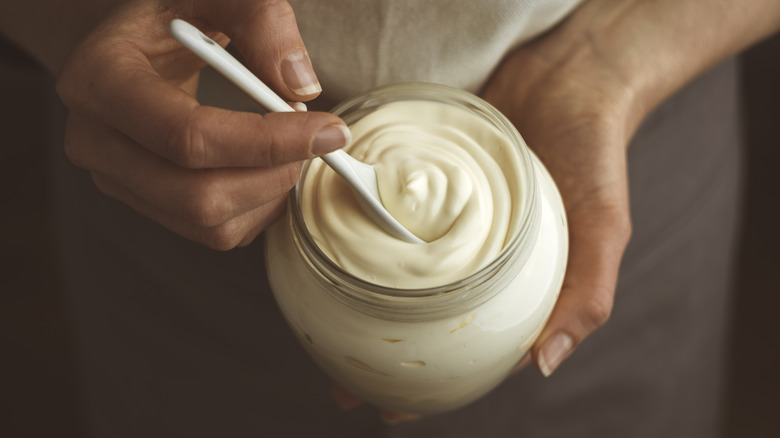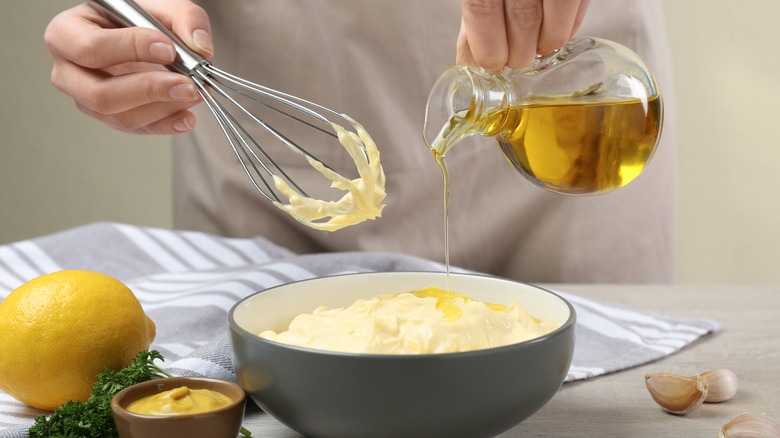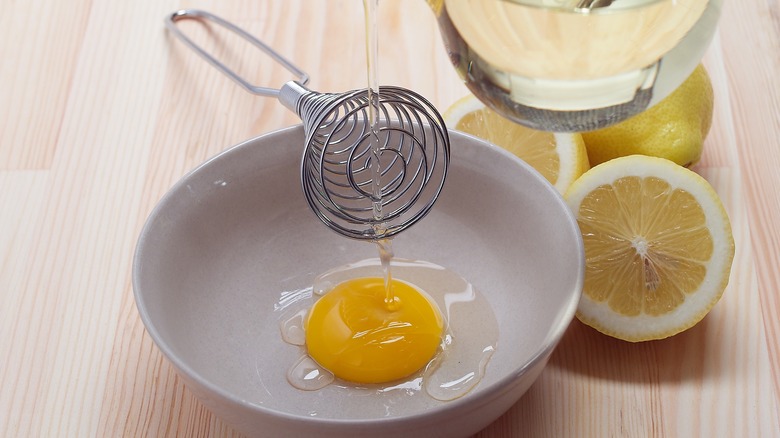Everything We Know About The Invention Of Mayonnaise
Mayo might be nearly ubiquitous in America, but it has a long history in other parts of the world — and that history is more than a little ambiguous. The classic egg-and-oil condiment is often described as coming from France or Spain, and in terms of what we in the 21st century would consider mayonnaise, that's more or less true. But that mayo only surfaced in the 1700s, and there are mayo-adjacent sauces from even further back.
Let's start with ancient Egypt: Egyptians at the time likely ate a sauce-like combination of eggs and olive oil, and the same goes for ancient Rome, where Romans cottoned onto the idea a little bit later. Information on what this "mayo" looked like (for example, whether it was emulsified) is scant — it's generally described as a precursor to mayo.
Perhaps a little closer to the present-day thing was aioli or allioli, made with garlic, salt, and olive oil. There are records of this existing in what is now present-day Catalonia as far back as the first century. However, without egg, it probably wouldn't have resembled present-day mayo either (egg was likely introduced at some later point, allowing the emulsification which characterizes mayo). Realistically, the most common birth date of mayonnaise tends to be listed as 1756, when a French chef created it to serve to the Duke de Richelieu.
The creation of modern mayo
The standard creation tale of mayonnaise goes like this: The Duke was leading the French army in victory over the British on the Spanish island of Menorca, during the Seven Years' War. To celebrate victory, his chef wanted to serve a dish with a cream-egg sauce, but there was no cream. He substituted olive oil for cream, and boom, the more-or-less modern-day mayonnaise was born. This story has endured for nearly three centuries, and it's one that big producers like Hellman's have subscribed to in recent times.
The Duke de Richelieu story does explain the name "mayonnaise": The chef named it "Mahonnaise" for the battle at Mahon. (As language inevitably evolved over time, the "h" at some point switched to a "y": This may have been due to a simple error, or perhaps because of some connection to the old French word for egg yolk, moyeu.)
While this is probably the most common story, it's not without detractors: One of the more prominent alternate theories is that mayo evolved out of the aforementioned allioli — most likely when somebody added egg to the recipe and turned it into an emulsion. It's suggested that this happened during the Renaissance, which would have been before 1756. There's no precise origin story here (that is, no one person to credit for creating it), but the story goes that it also originated out of Menorca, but that the Spanish had created it with the name "salsa mahonesa."
So is mayonnaise French or Spanish?
If the latter theory is believed — that mayonnaise was appropriated out of Catalonian allioli — then you could argue that it is a fundamentally Spanish sauce. However, even in this theory, the French still created the exact mayo that's used today — they just used allioli as the base, and presumably ditched the garlic. After all, present-day aioli (or garlic mayo) is considered distinct from regular ol' mayonnaise. This idea could be wrong, too: After all, by 1756, the French had already created Hollandaise sauce, of which mayonnaise could also be considered a variant.
Overall, mayonnaise has tended to be credited to the French, due to its large role in French cuisine: It's one of the French "mother sauces," integral to a large range of French dishes. There are other origin theories that center on France — for example, that it came from Bayonne in southwestern France (but also near to Spain) and was originally called "Bayonnaise." But more importantly, it was French chefs who made mayonnaise popular, effectively exporting it to places like Germany, Britain, and the U.S. starting in the 19th century (which is when it started its ascent towards becoming an all-American condiment). And just as importantly, it was a French chef, Marie-Antoine Carême, who refined the recipe into its more contemporary, emulsified version. So while there are good arguments for a Spanish origin, modern mayo is likely more French.


